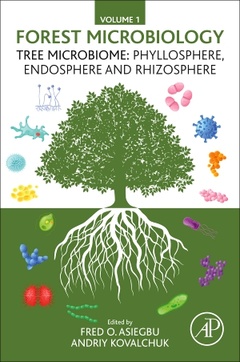Description
Forest Microbiology
Volume 1: Tree Microbiome: Phyllosphere, Endosphere and Rhizosphere
Forest Microbiology Series
Coordinators: O Asiegbu Fred, Kovalchuk Andriy
Language: English
Subjects for Forest Microbiology:
436 p. · 21.4x27.6 cm · Paperback
Description
/li>Contents
/li>Biography
/li>Comment
/li>
Forest Microbiology, Volume One: Tree Microbiome: Phyllosphere, Endosphere and Rhizosphere places an emphasis on the microbiology of leaves, needles, stems, roots, litter and soil. This comprehensive title is split into five sections, including the phyllosphere microbiome, endosphere, rhizosphere, archaea, viruses in forest ecosystem and microbiota of forest nurseries and tree pests, challenges and potentials. Microbial communities associated with various host trees and different tree tissues are compared, and generalists and specialists among tree-associated microbes are identified. In addition, biotic and abiotic factors determining the composition and the structure of forest tree microbial communities are presented, along with the concept of microbial ?hubs.'
Together, the book's editors have 25 years? worth of experience teaching and conducting research on forest microbiology, making this an essential read for any scientist interested in the forest microbiome.
Section A: Introduction 1. Trees and their microbial symbionts 2. Trees as microbial habitats: ecological niches offered by tree organs and tissues 3. Methods for studying microbiome of forest trees 4. Abiotic factors affecting the composition of forest tree microbiome 5. Interspecific interactions within microbial communities associated with forest trees 6. Protists in forest ecosystem
Section B: Phyllosphere microbiome 7. Fungal communities of conifer tree needles 8. Fungi associated with broad leaf trees of temperate forests 9. Fungal communities of tropical tree foliage 10. Bacteria biota of tree foliage 11. Microbiome of reproductive organs of trees
Section C: Endosphere 12. Bacterial biota of stems, branches and twigs 13. Fungi inhabiting woody tree tissues (stems, branches and twigs)
Section D: Rhizosphere 14. Microbiome of living roots 15. Mycorrhizal fungi associated with forest trees (ecological and physiological aspects of symbiosis) 16. Dark septate endophytes associated with forest trees 17. Microbiome of forest soil 18. Microbiome of decayed wood and forest litter
Section E: Archaea, viruses in forest ecosystem and microbiota of forest nurseries and tree pests 19. Microbiome of forest tree nurseries 20. Microbiome of forest tree pests (insect vectors) 21. Archaea as components of forest microbiome 22. Viruses as components of forest microbiome
Section F: Challenges and Potentials 23. Translational impact of forest microbiome 24. Major challenges and future perspective
Dr Kovalchuk is a researcher at the University of Helsinki. He has a PhD in molecular biology and has over 30 peer-reviewed journal publications on forest microbiomes.
- Addresses the microbiology of living organs of forest trees including needles, leaves, stems and roots
- Highlights the potential impact of microbiota inhabiting forest trees on the health and fitness of, and disease progression in, forest biomes
- Focuses on the phyllosphere, endosphere and rhizosphere forest microbiome




